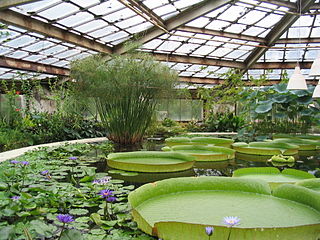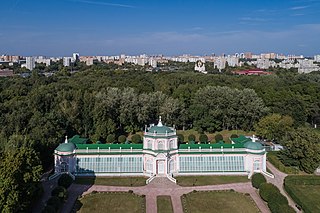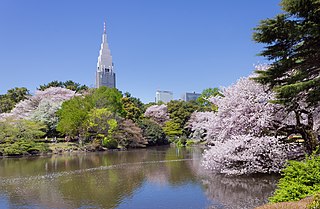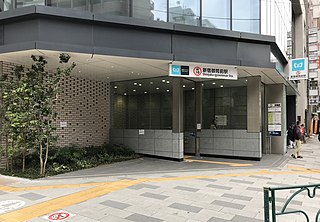
A greenhouse is a structure with walls and roof made chiefly of transparent material, such as glass, in which plants requiring regulated climatic conditions are grown.These structures range in size from small sheds to industrial-sized buildings. A miniature greenhouse is known as a cold frame. The interior of a greenhouse exposed to sunlight becomes significantly warmer than the external temperature, protecting its contents in cold weather.

Shinjuku is a special ward in Tokyo, Japan. It is a major commercial and administrative centre, housing the northern half of the busiest railway station in the world and the Tokyo Metropolitan Government Building, the administration centre for the government of Tokyo. As of 2018, the ward has an estimated population of 346,235, and a population density of 18,232 people per km2. The total area is 18.23 km2. Since the end of the Second World War, Shinjuku has been a major secondary center of Tokyo (fukutoshin), rivaling to the original city center in Marunouchi and Ginza. It literally means "New Inn Ward".

Shibuya is a special ward in Tokyo, Japan. As a major commercial and finance center, it houses two of the busiest railway stations in the world, Shinjuku Station and Shibuya Station.

A conservatory is a building or room having glass or other transparent roofing and walls used as a greenhouse or a sunroom. Usually it refers to a space attached to a conventional building such as a house, especially in the United Kingdom. Elsewhere, especially in America, it can often refer to a large free-standing glass-walled building in a botanic garden or park, sometimes also called a palm house if tall enough for trees. Municipal conservatories became popular in the early 19th century.

An orangery or orangerie was a room or a dedicated building on the grounds of fashionable residences of Northern Europe from the 17th to the 19th centuries where orange and other fruit trees were protected during the winter, as a very large form of greenhouse or conservatory.

The Kyōto Imperial Palace is the former palace of the Emperor of Japan. Since the Meiji Restoration in 1869, the Emperors have resided at the Tokyo Imperial Palace, while the preservation of the Kyoto Imperial Palace was ordered in 1877. Today, the grounds are open to the public, and the Imperial Household Agency hosts public tours of the buildings several times a day.

Shinjuku Gyo-en (新宿御苑) is a large park and garden in Shinjuku and Shibuya, Tokyo, Japan. It was originally a residence of the Naitō family in the Edo period. Afterward, it became a garden under the management of Japan Imperial Household Agency. It is now a national park under the jurisdiction of the Ministry of the Environment.

Shinjuku Central Park is a park in western Shinjuku, Tokyo, Japan. The park is bordered by Honnnan Dori and Kita Dori to the north, Junisha Dori to the west, Suido Dori or Minami Dori to the south, and Koen Dori to the east. The park is located directly in front of the Tokyo Metropolitan Government Building, and is surrounded by some of Tokyo's tallest buildings including the Hyatt Regency Tokyo, the Park Hyatt, and other hotels and office buildings.

Sendagaya Station is a railway station on the Chūō-Sōbu Line in Shibuya, Tokyo, Japan, operated by East Japan Railway Company.

Sendagaya (千駄ヶ谷) is an area within Shibuya ward, one of the 23 special wards of Tokyo.

The NTT Docomo Yoyogi Building is a skyscraper located in the Sendagaya district of Shibuya, Tokyo, Japan. At 240 meters (790 ft) tall, it is the fourth tallest building in Tokyo.

The University of Helsinki Botanical Garden is an institution subordinate to the Finnish Museum of Natural History of the University of Helsinki, which maintains a collection of live plants for use in research and teaching. The Botanical Garden has two separate sites: one in Kaisaniemi and one in Kumpula.

Shinjuku-gyoemmae Station is a subway station on the Tokyo Metro Marunouchi Line in Shinjuku, Tokyo, Japan, operated by the Tokyo subway operator Tokyo Metro. It is numbered "M-10".

Tokyo holds many festivals (matsuri) throughout the year. Major Shinto shrine festivals include the Sanno Festival at Hie Shrine, and the Sanja Festival at Asakusa Shrine. The Kanda Matsuri in Tokyo is held every two years in May. The festival features a parade with elaborately decorated floats and thousands of people.

The Shinjuku Mitsui Building is a high-rise building in Nishi-Shinjuku, Shinjuku, Tokyo. It is owned by Mitsui Fudosan. It is one of the ten tallest buildings in Tokyo, and was the tallest building in Tokyo and Japan from September 1974 to March 1978, when Sunshine 60 was completed.

Kansen-en Park is a Japanese garden located in Shinjuku, Tokyo. It covers an area of about 14,000 m2 (150,000 sq ft).

Allan Gardens is a conservatory and urban park located in the Garden District of Toronto, Ontario, Canada. The property includes a playground, off-leash dog park, and a 1,500 square metres (16,000 sq ft) conservatory with six green houses.
Hirotaka Kajiura is a Japanese professional shogi player ranked 7-dan.



















